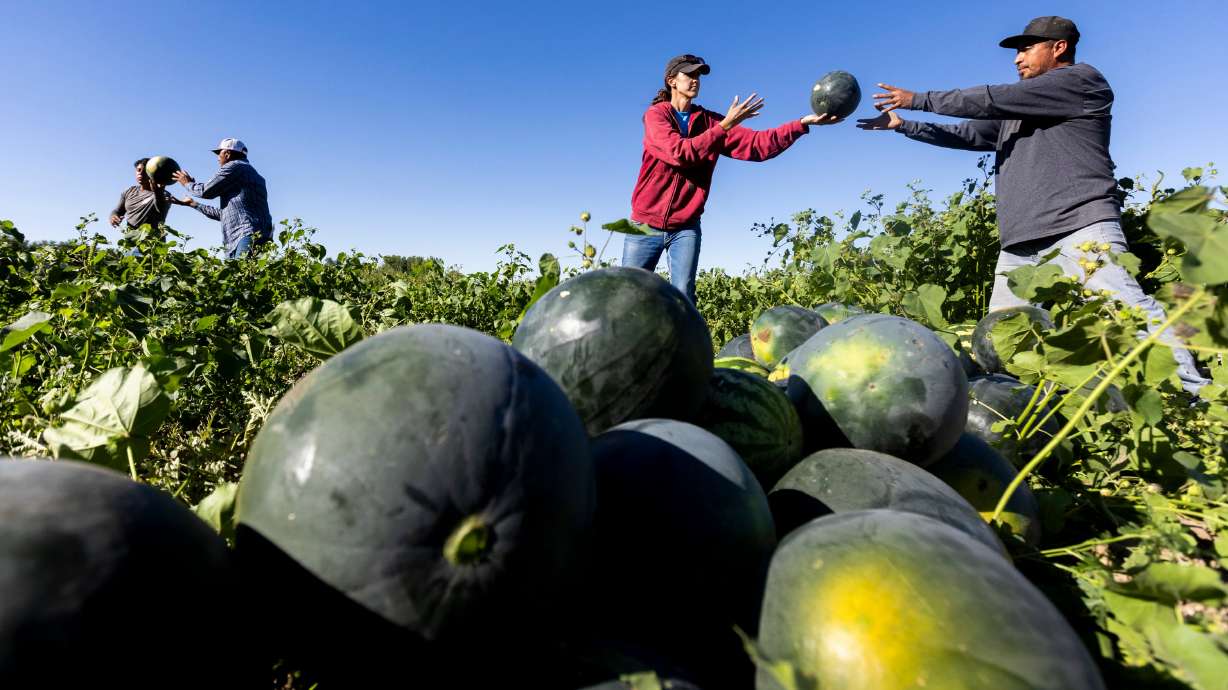Estimated read time: 4-5 minutes
This archived news story is available only for your personal, non-commercial use. Information in the story may be outdated or superseded by additional information. Reading or replaying the story in its archived form does not constitute a republication of the story.
- In Green River, watermelon farming thrives with the support of the local community, who meticulously tend to their crops under challenging desert conditions.
- The Vetere family, with longtime worker Raul Varela, produce what is claimed to be among the best watermelons in the nation.
- Despite challenges such as the underperforming Crenshaw melons this year, the family remains committed to their tradition.
Editor's note: This is one of two articles about the Green River, the Utah town called Green River and melon farming. Read the other article here.
This article is published through the Colorado River Collaborative, a solutions journalism initiative supported by the Janet Quinney Lawson Institute for Land, Water, and Air at Utah State University. See all of our stories about how Utahns are impacted by the Colorado River at greatsaltlakenews.org/coloradoriver.
GREEN RIVER, Emery County — Mark Twain once said, "When one has tasted watermelon, he knows what angels eat."
If so, the angels would love the melons produced in the rural Utah town of Green River, Emery County. Watermelon farmers in the area are meticulous in the care of their crops, like bakers who are driven to add just the right amount of flour, baking powder and baking soda, and not a smidgen more.
With a climate that is often scorching hot by day, watermelons must be protected by what are called "caps" against the heat of the sun. Water becomes trickier, as the melons demand just the right amount; too much can ruin a crop.
The desert conditions along the Green River with hot days and cool nights provide the perfect cultivation to produce what the growers — and the town — say are the best watermelons in the country.
Caring for the 'angel crop'
Just a day before the Watermelon Day parade in September, the Vetere family was harvesting another batch of the seedless Black Diamond watermelon.
Its flesh is ruby red, and like its name, it is such a dark green it almost looks black. Larger than a basketball, the watermelons get tossed from one person to another in a five-person chain until they end up on the side of a dirt road to be loaded into a truck for transport into town.
The boss, Raul Varela, is talking to the younger men in Spanish, directing a ballet of sorts — making sure each watermelon is handled with care, but expeditiously. There is no time to waste.

Heidi Vetere, a stay-at-home mom who is one of three daughters of Greg Vetere — the family patriarch who totes around a flip phone — said Varela has been an indispensable part of the operation — and a part of the family.
"I've known him since I was 4," she said. "He's been a part of us all of my life."
Varela has been with the family for 33 years, and many of the other workers also seemed to have found their calling, living in town and becoming a part of the community.
Being a melon grower — like any type of farming — means focused labor, long days, anxious study of the bookkeeping in a growing season that involves planting from the end of April until the end of June.
Each melon has to be planted by hand and harvested by hand — something Greg Vetere readily admits is a strain on the back.

The crop of the 70 acres he plants can be fickle. This summer the Crenshaw melon, thought to have its origin in Turkey, did not fare well. It is one of the most commonly requested melon species for purchase. The Crenshaw is like a cantaloupe but juicier, mild like a honeydew but extremely sweet. Its flesh is the color of peach, with a green rind. Its uses go far beyond just gulping it down. It can be used in a traditional fruit salad, in salsa, a smoothie or sorbet or wrapped in a piece of prosciutto. It is even used on a seasonal basis for a signature ale made in Colorado.
But this just wasn't the year for the Crenshaw, one of over 1,200 varieties in the watermelon family.
Each year, whatever disappointment might await, Vetere's three daughters, Jill, Heidi and Caitlyn, come from Grand Junction, Colorado, to help out on the farm to prepare for Melon Days. They also show up at other times when they have an itch to get back down to earth.
They all agree that it is in their blood to come back home.
"It's a family tradition to work as a family, and you're doing everything by hand, with the heat and no shade," said Jill Vetere. "It's not easy, but it's fun."
Added Caitlyn Vetere: "It's all hands on deck for Melon Days."

Here are a few fun facts about melons people may not know:
- They are a vegetable, not a fruit, and part of a family that includes squash, cucumbers and pumpkins;
- The watermelon is the "state vegetable" of Oklahoma;
- Watermelons are 92% water, but are a good source of vitamins A, C and loaded with potassium;
- Thomas Jefferson grew watermelons on his farm in Monticello;
- A Texas man holds the world record set in 1995 for distance in a watermelon seed spitting contest with a shot of 75 feet, 2 inches. That is four times the size of a giraffe;











